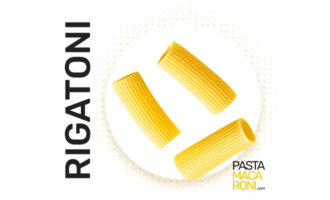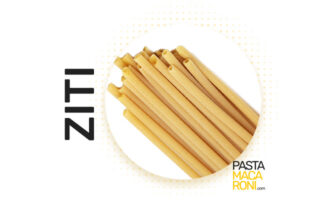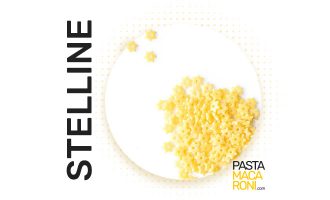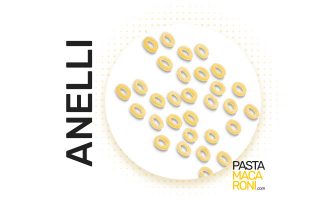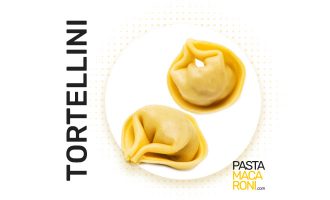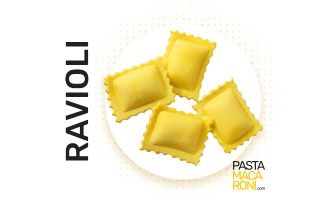The shape is a short tube-shaped paste with diagonal cuts on the diagonal. Size 30-50 mm in length and 8-10 mm in diameter.
Cooking time – 12 minutes (until ready).
Penne suitable for meat and vegetable sauces, go well with casseroles and cream gravies.
Briefly about Penne
Penne pasta is a type of pasta shaped like short, narrow tubes with diagonal cuts at the ends. It is made from wheat flour and water and is one of the main dishes of Italian cuisine. Penne pasta is versatile and can be used in a variety of dishes, from salads, casseroles and pasta sauces. Penne pasta is often served with tomato or cream-based sauces and is a good source of complex carbohydrates, protein and low in calories and fat. Cooking time for penne pasta varies, but usually takes 10-12 minutes when cooked in salted water.
You have come to make delicious Penne?
What does Penne pasta look like 📏 Shape of Penne pasta
Short pasta with diagonal oblique cuts and a ribbed surface.
It is about 8-10 mm in diameter, 30-50 mm long, and 1.2 to 1.5 mm thick.

What is Penne pasta | History of appearance and description
Penne pasta is a type of pasta that is shaped like tubes with diagonal cuts at both ends, which gives them a somewhat pointed appearance. They usually are made from durum wheat flour and water and can be either whole grain or white.
It is one of the most popular types of pasta in the world and is widely available in supermarkets and restaurants. It is particularly popular in the United States, where it is usually served with a tomato-based sauce. Penne pasta is also a great base for many other dishes, such as casseroles, salads, and soups. The popularity of penne pasta is due to its versatility, taste, and texture. The small tubes of pasta can be cooked in a variety of ways, such as boiled, baked or fried.
Penne pasta was invented in the mid-19th century in the Campania region of Italy. Penne Rigate is one of the most commonly used formats of short pasta in Italy. It was named for its resemblance to ancient writing pens. “penna” means pen, which quite describes the shape of the pasta.
Like many other types of pasta, Penne originated in the South of Italy, in the Campania region. However, other areas of the country have their own names for them. For example, in Umbria they are called “spole” (Italian for “shuttles”), and a little further south, they are called “maltagliati” (Italian for “badly sliced”).

Penne is also divided by shape
- Rigate (ribbed, striped);
- Lisce (smooth);
- Piccole (small).
The most common type of penne is the traditional “penne rigate,” which has ridges that help sauce cling to the pasta. Other types of penne include penne lisce, which is smooth, penne mezzani, which is shorter and skinnier, and penne mostaccioli, which is slightly larger and thicker. Penne pasta is usually made from durum wheat flour, but some types are made with other grains such as buckwheat or spelt. All Penne pasta has a hollow tube shape with diagonally slanted cuts but varies by species (more than 10).
Penne rigate
Feathers with a ribbed surface; Approximate dimensions: diameter 10 mm, length 35-40 mm, thickness 1.2 to 1.3 mm;

Penne lisce (mostaccioli)
Penne with a smooth surface. Approximate dimensions: diameter 10 mm, length 35-40 mm, thickness 1.2 to 1.3 mm.
Mostaccioli, known in Italy as penne lisse, are the signature dish of the Campania region of southern Italy, which includes the cities of Naples, Capri and Sorrento. Unlike penne rigate, which is ribbed, mostaccioli or Penne lisce have a smooth texture.

Penne mezzani rigate
Feathers with ribbed surface. They differ from Penne rigate by longer length and narrower width. Approximate size: 7mm diameter, 36-37mm length, 1.2-1.3mm thickness.
Penne Mezzani Rigate are thinner than regular penne, but they are still ribbed and hold flavor perfectly. They have the same cross section as Mezzani, the slanted cut of Penne and the taste of the best bronze pasta: Penne Mezzani Rigate are perfect with meat sauce or with vegetables.

Penne mezzani lisce
Feathers with a smooth surface. They differ from Penne lisce by longer length and narrower width. Approximate size: 7 mm in diameter, 36-37 mm in length, 1.2-1.3 mm in thickness.
A short, smooth pasta format with the same cross section as Mezzani, but with an oblique cut. The perfect ally for quick recipes with simple seasonal ingredients, Penne Mezzani Lisce has a porous texture and smells like Italian wheat. The name encapsulates all the characteristics of this short form bronze-colored pasta: Penne Mezzani Lisce came about through a love of pasta-making tradition.

Pennette
Reduced quills with a ribbed or smooth surface. Approximate sizes: diameter 5-6 mm, length 12-13 mm and thickness 1.1 to 1.2 mm.
Penne a Candela
Feathers with a smooth surface. They differ from Penne lisce in increased thickness and reduced length. Approximate size: diameter 13mm, length 42mm, thickness from 1.2 to 1.35mm.
Penne piccole rigate
Even smaller feathers with a ribbed surface, compared with Pennette rigate. Approximate size: diameter 5 mm, length 31-32 mm, thickness 1,1-1,2 mm.
Penne piccole lisce
even smaller feathers with a smooth surface, compared with Pennette rigate. Approximate dimensions: diameter 5-6 mm, length about 34 mm; thickness 1-1.1 mm.
Substitute for penne pasta
If you don’t have penne pasta on hand or want to diversify the recipe, there are several other types of short pasta you can substitute penne with. Some options include Tortiglioni, Maccheroni or Cavatappi. These types of pasta are similar in shape and size to penne and can be used interchangeably in most recipes.
Features of Penne pasta
One of the advantages of Penne pasta is that it pairs well with various sauces, including tomato, cream and pesto. They are often used in dishes like Penne alla Vodka, a popular pasta dish made with creamy tomato sauce and vodka, and Penne arrabiata, a spicy tomato sauce with chili peppers.
The short pasta type is a versatile short pasta that can be matched with any sauce. This type of pasta has been conceived from the beginning as a basis for culinary experimentation and experimentation. This is evidenced by a large number of different shapes of this pasta.
There are many companies that make Penne pasta, including Barilla, De Cecco and Rana. These companies are known for their high-quality pasta products and are popular with home cooks and professional chefs alike.
What to mix it with Penne
Penne goes well with both thick and bright and light and unobtrusive sauces.
Penne Rigate goes very well with different sauces, including the classic tomato or meat sauces and creamy, cheesy, and fishy ones. Penne pasta is often served with tomato sauces such as marinara or arrabbiata, and with creamy sauces such as alfredo or carbonara. It can also be combined with vegetables, meat or seafood for a more complete dish. Penne pasta is also popular in salads because it holds the dressing well and combines easily with a variety of ingredients. In turn, they are perfect for all kinds of casseroles.
Penne Rigate would be perfect in the classic recipe for “Boscaiola” pasta with dried porcini mushrooms and ham, for example.
⏲️ Cooking time | How long to cook penne pasta
- Boiling until done – 12 minutes
- Al dente – 10 minutes
The cooking time for penne pasta depends on the specific recipe and the type of pasta you are using. In general, most types of penne pasta require about 10-12 minutes of boiling in salted water. It is important to follow the cooking instructions on the package and check the pasta for readiness before draining the water.

🗒️ Calories and Nutritional Value
- Energy value 1502 kJ / 359 kcal
- 2 g fats
- Carbohydrates 70 g
- Proteins 14 g
Nutritional Factors (per 100g) – Barilla Pasta Penne Rigate n.73, 450g.
Like most types of pasta, penne is made from wheat flour and is a good source of complex carbohydrates. It is also relatively low in calories and fat. One serving of penne pasta (about 2 ounces) contains about 200 calories, 1-2 gram of fat, and 45 grams of carbs. It is also a good source of protein – about 7 grams per serving. However, it is important to note that the nutritional value of penne pasta can vary depending on the type of wheat flour used and any additional ingredients such as eggs or spinach.
As mentioned before, penne pasta is made from durum wheat flour. This type of flour is high in protein and is an excellent source of dietary fiber, vitamins, and minerals. This makes it a healthier option than other pastas, and it is a great choice for those who are looking to add more whole grains to their diet. Additionally, penne pasta is low in calories, fat, and sodium, making it a great choice for those who are trying to maintain a healthy weight.
🍝 The Best Recipes with Penne Pasta | 5 easy and delicious dishes
Penne pasta is a popular type of pasta that is shaped like a tube. It comes from Italy, where it is traditionally used in many dishes. Penne pasta is popular because of its versatility. It can be used in a variety of dishes, from salads to soups to casseroles. It can be cooked quickly and easily, making it a great choice for busy households. It goes with many sauces and can be used to make delicious and hearty meals. Whether you’re looking for a quick dinner or a more elaborate dish, Penne pasta is sure to be a hit in your kitchen.
When it comes to making penne pasta dishes, the possibilities are endless. From classic Italian dishes like penne alla vodka to more creative dishes like penne pesto. Penne are incredibly versatile, this pasta can be combined with chicken, mozzarella, creamy garlic sous, tomato basil sous, creamy alfredo, parsley, red pepper flakes and other ingredients in a variety of recipes. The best penne pasta recipes often use simple ingredients to enhance the flavor of the pasta. Here are a few of our favorite penne pasta recipes that are sure to please any company.
Here’s a look at all the reasons many people love penne pasta, from its versatility to its nutritional value. Whether you’re cooking for one or a large family, this dish is sure to please everyone!
Penne 4 Cheese | Traditional pasta
It’s an excellent time to remember some simple and delicious Italian recipes for cooking at home. Today it’s pasta four cheese.
Ingredients for penne four cheese, you will need:
- Penne – 450 g
- Fresh cheese brynza or other soft cheese – 90 gr
- Cheddar cheese – 60 gr
- Molded cheese – 60 g
- Parmesan – 25 g
- Cream 30% – 200 g
- Nutmeg – 0.5 g (to taste)
- Black pepper – 0.5g (to taste)
Penne Alla Vodka in Italian
Penne alla vodka is a classic Italian dish that features a creamy tomato sauce and penne pasta. This dish is creamy, comforting, and easy to make. You can make it with either store-bought or homemade vodka sauce for a delicious weeknight meal.
Penne alla vodka was a very popular dish in the 80s and 90s, and while it’s hard to determine its origins, one thing is for sure: it has completely transformed outside of Italy, so my goal is to bring it back to its roots! Have you ever noticed how much more ingredients are often in a fake recipe? This dish is a reminder of how unnecessary they are!
INGREDIENTS:
- 300 g Penne Rigate.
- 2 small cans of Italian peeled tomatoes 800g
- 200 grams of cream from 20%
- 200 grams of cooked pancetta/bacon
- Extra virgin olive oil
- Basil
- ½ onion (sliced)
- 3 Tbsp. Pecorino Romano or Parmesan
- 1 tsp. salt
- 100 ml of vodka
Baked penne pasta with cheese
For a more indulgent dish, try baked penne with cheese. This dish combines penne pasta with a creamy cheese sauce, making it a rich and flavorful meal. You can also add vegetables like mushrooms or spinach to this dish for added nutrition.
Baked penne pasta is a popular pasta dish that is made by baking a layered mixture of cooked penne pasta, a cooked meat sauce of ground beef with spicy ingredients and a white sauce of whole cream and instant cheese. The meat sauce is made by roasting ground beef with tomato sauce, tomato paste, onions, garlic, sugar, cream, grated cheese and seasoned with Italian seasoning, pepper and salt. Perfect for all pasta and cheese lovers.
INGREDIENTS
For penne pasta:
- 400 grams penne pasta (uncooked)
- salt
- water
For the meat sauce:
- 400 grams of ground beef
- 2 tablespoons tomato paste
- 2 cups tomato sauce
- ½ cup onions (minced)
- 3 garlic cloves (minced)
- salt and pepper to taste
- 1 teaspoon dried oregano or Italian seasoning
- 2 tablespoons sugar (optional)
- ½ cup cooking cream
- ½ cup grated cheese
For white sauce:
- 1 cup all-purpose cream
- 1 cup quick melted cheese
Simple Veg Penne – vegetarian version of Primavera’s healthiest pasta
If you’re looking for a vegetarian option, try roasted vegetable penne. This light and flavorful dish is sure to be a hit with vegetarians and meat-eaters alike.
An easy and quick to make vegetarian pasta dish that is healthy. This dish is healthy because it is rich in vegetables and contains less pasta, therefore less carbohydrates.
Pasta Primavera means “spring pasta,” usually associated with seasonal spring vegetables. The idea is to buy local seasonal fresh vegetables.
This dish is easy to make because it’s cooked in one pot, not counting the water for the pasta, and the vegetables retain their firmness and freshness. All the leaked nutrients just stay in the sauce. The best part is that it still feels like you’re eating a huge serving of pasta, but you’re actually consuming almost half of a regular serving of pasta.
Ingredients
- 10 oz – 285 g penne pasta
- ½ cup extra virgin olive oil
- 4 garlic cloves
- ½ tsp. chili flakes
- 8 oz – 230 g green beans
- 8 oz – 230 g asparagus
- 8 oz – 230 g grape tomatoes or cherry tomatoes
- 6 spring onions (green onions)
- 1 cup frozen peas
- ½ cup heavy cream
- ¾ cup fresh basil leaves
- 1 lemon zest
- 1 cup parmesan cheese
Recipe for creamy penne pasta with pesto sauce
For a lighter option, try penne pesto. This dish features fresh pesto sauce, penne pasta, and cherry tomatoes. The flavors of the pesto and the tomatoes pair perfectly with the penne, making it a simple yet flavorful dish.
Ingredients for Pasta with Creamy Pesto:
- Penne pasta – 1 cup,
- Salt to taste,
- Butter – 1 tbsp,
- Olive oil – 2 tablespoons,
- Finely chopped garlic – 1 tbsp,
- Chopped onion – small,
- Cherry tomato,
- crushed pepper,
Pesto sauce
- Preparation Basil – 2 handfuls,
- Walnuts – 1 cup,
- Garlic – 7-8 cloves,
- Parmesan cheese – 1 cup,
- Olive oil – 4 tablespoons,
- Salt to taste
No matter what type of penne pasta dish you’re looking for, there’s sure to be one that appeals to you.
FAQ about Penne pasta
-
What is penne pasta?
Penne pasta is a popular type of pasta that is shaped like tubes with diagonal slits on both ends. It was invented in Italy in the mid-19th century and goes well with various sauces. Penne pasta is versatile and can be used in a variety of dishes, from pasta salads to casseroles and sauces. It is also popular for baked pasta dishes because the tubes hold the sauce well and provide a hearty flavor. It takes about 10-12 minutes to cook and is made by companies such as Barilla, De Cecco and Rana.
-
Are There Healthy Alternatives to Penne Pasta?
Yes, there are alternatives. Healthy alternatives to penne pasta are becoming increasingly popular as people look for more nutritious ways to enjoy their Italian favorites. Whole wheat and quinoa pasta are two of the most popular substitutes, but there are also other options such as chickpea, lentil, and black bean pasta. These provide a good source of fiber, protein, and other essential nutrients without sacrificing taste. For those looking for a gluten-free option, there are now gluten-free versions of penne pasta available made from brown rice, buckwheat, or corn flour. Eating these healthy alternatives to penne pasta can help you reduce your calorie intake, improve your digestive health, and help you reach your weight loss goals.
-
How to Store and Reheat Leftover Penne Pasta?
Storing and reheating leftover penne pasta can be tricky. It’s important to store it properly to ensure it retains its flavor and texture. If the cooked pasta is not stored in an airtight container, it can become soggy and lose its flavor. To preserve the taste and texture of your penne pasta, it is best to store it in the refrigerator for up to four days. When reheating, it is important to use a low heat setting and add a few tablespoons of water to the pasta to prevent it from drying out. Additionally, adding a little olive oil or butter to the pasta will help keep it moist and flavorful.
🧑🍳 How to Cook Perfectly Al Dente Penne Pasta
Cooking al dente penne pasta is a skill that can be mastered with practice. Cooking al dente penne pasta is a skill that can be mastered with practice. To achieve the perfect al dente pasta, you need to start with the right amount of water, salt, and the right type of penne pasta.
- First, fill a large pot with cold water and add 1 tablespoon of salt.
- Now, add the penne pasta to the pot, stirring occasionally.
Depending on the type of pasta, it will take between 8 to 11 minutes to cook.
- After the pasta is cooked, it should be slightly firm and not mushy.
To test the pasta, take a piece out of the pot and bite into it. If it is still slightly firm and not mushy, it is ready.
- To finish off, drain the penne pasta in a colander and serve hot.
Common Mistakes in Making Penne Pasta
Making Penne pasta is an art form, and there are some common mistakes that can lead to a less than perfect dish. One of the most common mistakes is not boiling the pasta for long enough. Penne should be cooked for around 8 minutes in order to get the al dente texture. Another mistake is not using enough water. The ratio of water to pasta should be 3:1. Not adding enough salt to the cooking water can also lead to a bland dish, so be sure to add a tablespoon of salt. Finally, it is important to stir the pasta frequently while it cooks, to ensure it doesn’t stick together. With these tips in mind, you can make the perfect penne pasta dish!
Cooking summary
The nutritional benefits of penne pasta can be enjoyed when it is cooked to perfection. It is important to remember that overcooked pasta can lead to a mushy texture, which will not provide the same nutritional benefits as perfectly cooked al dente penne pasta. With practice, you can master the art of cooking al dente penne pasta and enjoy its nutritional benefits.
Let’s summarize about penne pasta
Penne pasta is a popular type of pasta with a cylindrical shape cut diagonally at both ends. It is often used in pasta recipes because it pairs well with various sauces and ingredients. One of the best penne pasta recipes is the classic tomato sauce with parmesan cheese and basil. Simply boil the pasta in a large pot of boiling water until al dente, then drain. In a separate pan, heat the tomato sauce over medium heat and add the cooked penne pasta. Sprinkle grated parmesan cheese and fresh basil on top, then serve.
There are many delicious and easy pasta recipes, and penne pasta is a great weeknight option. Whether you prefer a classic tomato sauce, a creamy alfredo sauce, or a flavorful pesto sauce, penne pasta is the perfect vessel for any sauce. So the next time you’re craving pasta, try one of these penne pasta recipes!

